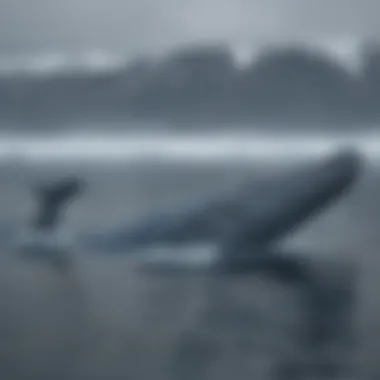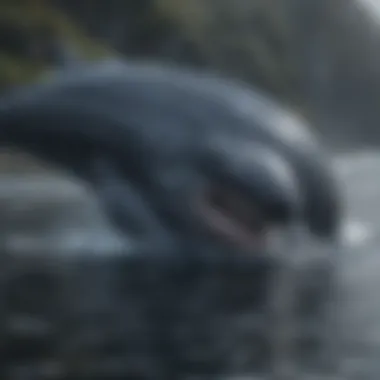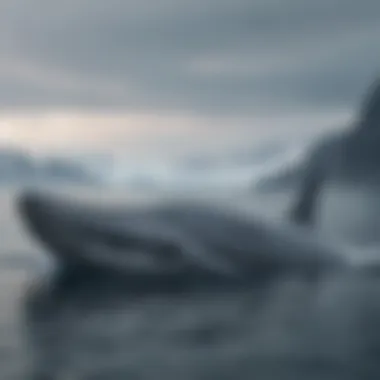Unveiling the Diverse Habitats of the Majestic Blue Whale


Nature Topic Overview
In this comprehensive exploration of the blue whale's habitat, we delve into the geographical regions where this magnificent creature, the largest on Earth, thrives. From the frosty expanses of the Arctic to the icy vastness of the Antarctic, we unravel the migration patterns and unique characteristics that define this marine giant. Prepare to embark on a journey through the oceans to uncover the mysteries of the blue whale.
Fun Facts and Trivia
As we venture into the world of the blue whale, it's fascinating to discover some intriguing facts about these colossal creatures. Did you know that a blue whale's heart is the size of a small car? Or that their tongues alone can weigh as much as an elephant? Through engaging visuals and interactive elements, young readers can grasp the sheer size and magnificence of these gentle giants, making learning about them an exciting adventure.
Wildlife Explorations
Our marine exploration extends beyond the blue whale to other species that share its habitat. Learn about the diverse array of marine life that coexists with these majestic creatures, from the tiny krill they feed on to the various fish and seabirds that call these oceanic regions home. Engage in interactive quizzes and puzzles to test your knowledge of the marine ecosystem, offering a deeper understanding of the interconnectedness of life beneath the waves.
Environmental Awareness
Delving into the habitat of the blue whale also underscores the importance of conservation and sustainability efforts. Discover why protecting these marine environments is crucial for the survival of not only the blue whale but countless other species. Gain valuable insights into how children can contribute to nature conservation, empowering them to become stewards of the environment and champions for marine life protection.
DIY Nature Activities
For young explorers eager to bring their learning to life, we provide a range of hands-on activities and experiments to try at home. From creating marine-inspired crafts to embarking on outdoor explorations to apply newfound knowledge, children can actively engage with nature and deepen their connection to the oceanic world. With step-by-step guides and detailed suggestions, there are endless possibilities for immersive learning experiences surrounding the habitat of the awe-inspiring blue whale.
Introduction
Overview of the Blue Whale
The Blue Whale's physical characteristics are a testament to its status as the largest animal on Earth. Its immense size, reaching up to 100 feet in length, and distinctive blue-gray coloration set it apart from other marine species. Exploring these physical attributes provides a deeper understanding of how the blue whale navigates through its vast oceanic habitat.
When it comes to the diet and feeding habits of the blue whale, its consumption of nearly 4 tons of krill daily underscores its position as a vital component of the marine food chain. This section delves into the feeding behaviors and dietary requirements that sustain the blue whale's colossal size and energetic needs.
The importance of the blue whale in marine ecosystems cannot be overstated. As a keystone species, these gentle giants play a crucial role in balancing oceanic ecosystems by regulating the population of krill and other prey species. Examining their significance sheds light on the intricate web of interactions that support marine life at large.


Habitat of the Blue Whale
Arctic Region
Migration Routes
In the Arctic region, blue whales follow intricate migration routes as they traverse through the icy waters in search of plentiful food sources. These migration routes play a pivotal role in sustaining the blue whale population and are essential for their survival. The cold waters of the Arctic provide ideal conditions for the blue whales to thrive, leading to a cyclic pattern of migration that influences their overall well-being.
Feeding Grounds
The feeding grounds in the Arctic region represent vital areas where blue whales congregate to feed on krill and small fish. These feeding grounds are characterized by high productivity, offering an abundance of prey for the blue whales to sustain their massive size and energy needs. The unique feature of these feeding grounds lies in their seasonal fluctuation, aligning with the availability of prey species, which impacts the blue whales' feeding behavior and movement within the region.
Antarctic Region
Breeding Sites
In the Antarctic region, blue whales are known to utilize specific breeding sites where they engage in courtship rituals and mating activities. These breeding sites are crucial for the continuation of the blue whale population, ensuring the genetic diversity and reproductive success of these marine giants. The key characteristic of these breeding sites is their isolation and protection, creating a safe environment for the birth and nurturing of blue whale calves.
Climate Adaptations
Blue whales in the Antarctic region have developed unique climate adaptations to survive in the extreme cold conditions of their habitat. These adaptations include thick blubber layers for insulation, streamlined body shapes for efficient movement in water, and complex vocalizations for communication in icy waters. The advantage of these climate adaptations is evident in the blue whales' ability to thrive in one of the harshest environments on Earth, showcasing their resilience and evolutionary prowess.
Habitat of the Blue Whale
Migration Patterns
Migration patterns play a crucial role in the life of the intriguing blue whale. These immense creatures undertake astonishing journeys across vast oceanic expanses, showcasing unparalleled determination and endurance. By comprehending the migration patterns of blue whales, scientists and researchers gain invaluable insights into their behaviors, preferences, and adaptations. Understanding the factors that drive these majestic mammals to embark on such arduous journeys is key to ensuring their conservation and protection.
Seasonal Movements


The seasonal movements of blue whales are a testament to their remarkable resilience and evolutionary adaptations. As the cold currents shift and food availability fluctuates, these immense creatures navigate with remarkable precision to optimize their feeding opportunities. Factors influencing migration, such as the abundance of krill, ocean temperatures, and daylight duration, dictate the blue whale's movements with precision. This synchronization with environmental cues underscores the intricate relationship between blue whales and the marine ecosystems they inhabit. By delving deeper into the nuances of these seasonal movements, a greater appreciation for the biological marvel of the blue whale emerges.
Threats to Blue Whale Habitat
In this article section, the focus shifts towards understanding the critical aspects that pose threats to the habitat of the majestic blue whale. This segment delves into the intricate relationships between human activities and the ecosystem where these marine giants reside.
Human Impact
Pollution
Pollution emerges as a central concern regarding the well-being of blue whale habitats. The insertion of contaminants such as plastics and chemicals into the marine environment disrupts the delicate balance crucial for the survival of these colossal creatures. This interference not only alters the quality of water but also jeopardizes the food chain, impacting the availability of prey fundamental to the blue whale's sustenance. Furthermore, the prolonged exposure to pollutants can lead to severe health issues for these magnificent beings.
Shipping Lanes
The navigation pathways frequented by ships, known as shipping lanes, propose another challenge to the blue whale habitat. The increased maritime traffic in these zones heightens the risk of collisions between vessels and whales, resulting in injuries or fatalities. Moreover, the noise pollution generated by shipping activities can interfere with the whale's communication and echolocation abilities, essential for navigation and locating food sources. This disruption further compounds the challenges already imposed by human intervention in their environment.
Climate Change Effects
Ocean Temperature Rise
The escalating ocean temperatures directly influence the habitat of the blue whale. As thermal levels surge due to climate change, the availability of suitable feeding grounds and breeding sites undergo substantial modifications. Blue whales rely on specific temperature ranges for optimal foraging conditions, and any fluctuations in these levels can disrupt their feeding patterns and migratory behaviors. Additionally, the warming waters contribute to the alteration of marine ecosystems on which these marine mammals depend, illustrating a concerning trend for their long-term survival.
Impact on Prey Availability
The repercussions of climate change extend to the prey availability for blue whales. Alterations in oceanic conditions affect the distribution and abundance of krill and other small marine organisms that constitute the primary diet of these leviathans. Diminished prey populations due to changing environmental factors pose a significant threat to the sustenance of blue whales, potentially leading to nutritional deficiencies and population decline. This intricate interplay between climate variations and prey dynamics underscores the vulnerability of these magnificent creatures amidst the changing oceanic landscape.
Conservation Efforts
In this section, we delve into the vital topic of Conservation Efforts regarding the Blue Whale habitat. As the largest creature on Earth, the protection and preservation of the blue whale species are of utmost importance to maintain the balance of marine ecosystems. Conservation efforts encompass a range of strategies and initiatives aimed at safeguarding these majestic marine giants. These efforts not only benefit the blue whales themselves but also have positive ripple effects throughout the entire marine ecosystem.


Conservation efforts play a crucial role in raising awareness about the threats faced by blue whales, such as human impact and climate change. By implementing targeted conservation measures, we can mitigate these threats and ensure the long-term survival of blue whale populations. Moreover, conservation efforts help in promoting sustainable practices and responsible eco-tourism to minimize disturbances to these magnificent creatures.
One of the key aspects of Conservation Efforts discussed herein is the emphasis on education and outreach programs. These programs aim to educate the public, especially younger generations, about the significance of blue whales in marine ecosystems. By fostering a sense of stewardship and respect for these creatures, we can cultivate a culture of conservation that extends beyond just the blue whale species.
International Regulations
Whale Sanctuaries
Whale sanctuaries serve as designated areas where blue whales and other marine mammals are protected from harmful activities such as hunting and pollution. These sanctuaries play a pivotal role in providing a safe haven for blue whales to breed, feed, and thrive without external threats. The core characteristic of whale sanctuaries is their focus on conservation and preservation of biodiversity.
In this context, whale sanctuaries are a popular choice for this article due to their direct relevance to the conservation efforts aimed at protecting blue whale populations. By establishing these sanctuaries, authorities can enforce regulations that limit human interventions and safeguard the natural habitats of blue whales. The unique feature of whale sanctuaries lies in their ability to create safe spaces where these gentle giants can exist without fear of harm.
An advantage of whale sanctuaries in this article is their contribution to scientific research and environmental monitoring. By studying the behavior and health of blue whales within these sanctuaries, researchers can gather valuable data to inform conservation strategies effectively. However, a notable disadvantage is the challenge of enforcement and illegal activities that may still threaten these protected areas.
Protected Areas
Protected areas designated for blue whales serve as additional measures to ensure their well-being and survival in their natural habitats. These areas are managed to restrict certain human activities that could adversely impact the blue whale populations. The key characteristic of protected areas is their focus on sustainable resource management and biodiversity conservation.
Protected areas are a beneficial choice for this article as they reinforce the importance of creating safe spaces for blue whales within their habitats. By delineating these areas, conservationists can establish clear boundaries to prevent human encroachment and disturbances. The unique feature of protected areas is their role in promoting eco-conscious practices and fostering harmonious coexistence between humans and blue whales.
One advantage of protected areas in this article is their capacity to act as learning hubs for environmental education and ecotourism. By allowing controlled access to these areas, visitors can witness the beauty of blue whales in their natural environments, sparking conservation awareness. Nevertheless, a challenge faced by protected areas is the balancing act between public accessibility and conservation priorities, which requires meticulous management and oversight.
Conclusion
The Conclusion section of this intricate exploration of Blue Whale habitats encapsulates the paramount significance of understanding these majestic creatures' habitats. Shedding light on the crucial interplay between environmental stability and the existence of these magnificent beings, the Conclusion serves as a pivotal reminder of our responsibility towards marine ecosystems. By unraveling the mysteries of Blue Whale habitats, we gain profound insights into the delicate balance of nature. It underscores the urgent need to safeguard these habitats and respect the intricate web of life that they support. The implications of this exploration ripple far beyond the confines of marine biology, delving into broader themes of conservation, ecological resilience, and the inherent interconnectedness of all life forms.
Significance of Understanding Blue Whale Habitat
Sustainability of Marine Ecosystems
Diving into the realm of the Sustainability of Marine Ecosystems within the context of understanding Blue Whale habitats reveals a nuanced tapestry of ecological intricacies. This aspect unveils the fundamental role that Blue Whales play in maintaining the equilibrium of marine ecosystems. The sheer presence of these colossal creatures acts as a barometer of ecosystem health, reflecting the vitality of the oceans they inhabit. The Sustainability of Marine Ecosystems hinges on the preservation of Blue Whale habitats, emphasizing the need for concerted conservation efforts to ensure long-term ecological sustainability. A key characteristic of this dynamic is the resilience exhibited by marine ecosystems when Blue Whale habitats are safeguarded, showcasing nature's remarkable ability to thrive when in harmonious balance with its inhabitants.
Educational Value
Exploring the Educational Value inherent in understanding Blue Whale habitats opens a gateway to a treasure trove of knowledge for both young minds and seasoned naturalists. This aspect enriches our understanding of marine biodiversity and fosters a deep-seated sense of stewardship towards the environment. The Educational Value of delving into Blue Whale habitats lies in its capacity to inspire curiosity, instill awe, and ignite a passion for conservation in the hearts of future generations. By showcasing the unique adaptations and behaviors of Blue Whales within their habitats, this exploration serves as a beacon of scientific learning and environmental awareness. Its distinctive feature lies in its ability to bridge the gap between theoretical knowledge and hands-on conservation, empowering individuals to become ambassadors for marine conservation efforts.







